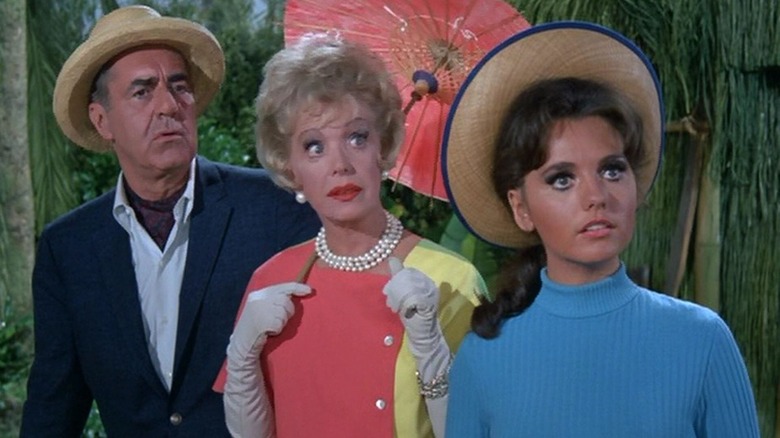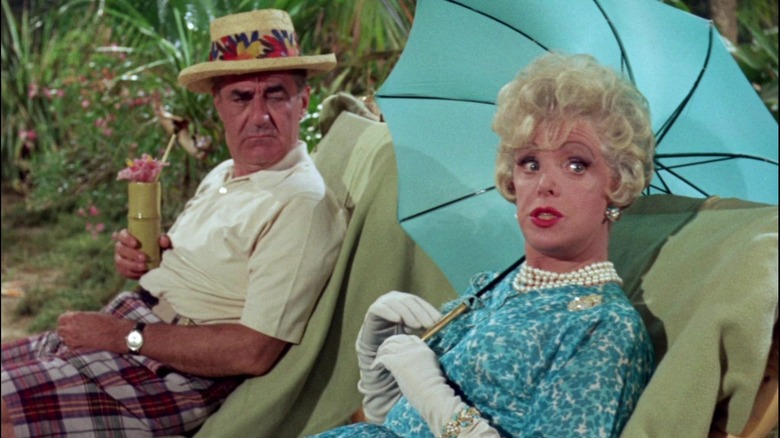How The Howells Had So Many Clothes While Stranded On Gilligan's Island
In his 1992 piece "Reflections after 25 years at the movies," the late, great film critic Roger Ebert observed: "Look at a movie that a lot of people love, and you will find something profound, no matter how silly the film may seem." You can extend that sentiment to any other artistic medium, television included. Even a fluffy slapstick show like "Gilligan's Island" has an unspoken depth that's kept viewers coming back to it decades after it went off the air.
According to creator Sherwood Schwartz, who passed away in 2011 after a long, prolific TV career, people were quick to assume the '60s sitcom began as a comedic spin on the Robinson Crusoe story. However, he maintained that the series was really born out of his desire to make a show about what might happen if a group of people from different walks of life somehow found themselves stuck together and had to depend on one another to survive. "Gilligan's Island" embodies Schwartz's hope that certain individuals, given the right circumstances, could learn to exist in harmony. (Charlie Kaufman, who nobody would ever accuse of being a bleeding heart, naturally had a much darker take on this premise when he pitched a "Gilligan's Island" reboot in the '90s.)
At the same time, the show doesn't pretend that social factors like wealth and class would magically cease to matter among a group of castaways shipwrecked on a remote desert island. Even on "Gilligan's Island," rich people still tend to stay on top and have more than anyone else. The way Schwartz told it, this idea is reflected in the endless amount of clothing owned by the island's most affluent residents, Wall Street tycoon Thurston Howell III (Jim Backus) and his wife Eunice (Natalie Schafer) — even if, practically speaking, it doesn't make a lick of sense for them to have all that on hand.
The politics of Gilligan's Island
The notion that anyone aboard the S.S. Minnow would've brought extra clothing for a would-be short boat tour is but the tip of the iceberg when it comes to the faulty logic of "Gilligan's Island." Far from an oversight, the show's creatives deliberately chose to avoid explaining its nonsense, reasoning (correctly) that it was funnier that way. Sherwood, more importantly, recognized that none of these quibbles actually mattered; he wasn't making a grounded drama, he was making a featherlight comedy full of understated insight into the human condition.
Be that as it may, Sherwood admitted fans wouldn't stop interrogating him about the Howells' wardrobe in his 1994 book "Inside Gilligan's Island: A Three-Hour Tour Through The Making Of A Television Classic." Clarifying that they were originally the only characters "intended to have changes of costume –- and extensive changes, at that," he added:
Parenthetically, I should say here that the second most frequently asked question about "Gilligan's Island" is, "Where did the Howells get all those clothes on that desert island?"
The answer to that question is philosophic, like some other things in "Gilligan's Island." The endless wardrobe was symbolic comment. It was my way of saying rich people manage somehow to have the best of everything, no matter what the circumstances.
This is also why the show's sympathies lie with the other characters, the hapless Gilligan (Bob Denver) especially, more than they generally do the Howells. You might not think of "Gilligan's Island" — a show where the bumbling Gilligan and his adorably explosive boss The Skipper (Alan Hale Jr.) are constantly getting smacked on the head with coconuts (rubber ones, Sherwood clarified) — as a political series in the slightest. But look a little closer at any work of art and you may yet be surprised by what you find.

